Class Rectangle should have 13 methods In particular in addi
Class Rectangle should have 13 methods. In particular, in addition to the constructor (i.e. __init__ method) and three methods that override python\'s object methods (and make your class user friendly as suggested by the test cases), your class should contain the following 9 methods: get_bottom_left, get_top_right, get_color, reset_color, get_perimeter, get_area, move, intersects, and contains. Here is a description of three of those methods whose job may not be obvious from the test cases. * Method move: given numbers dx and dy this method moves the calling rectangle by dx in the x direction and by dy in the y-direction. This method should not change directly the coordinates of the two corners of the calling rectangle, but must instead call move method from the Point class. * Method intersects: returns True if the calling rectangle intersects the given rectangle and False otherwise. Definition: two rectangles intersect if they have at least one point in common, otherwise they do not intersect. * Method contains: given an x and a y coordinate of a point, this method tests if that point is inside of the calling rectangle. If yes it returns True and otherwise False. (A point on the boundary of the rectangle is considered to be inside).
my attempt (but does not work):
class Rectangle:
def __init__(self,wdith, height,colour):
\'\'\'(Point,number,number)->None
identifies rectangle at position, with pt1, pt2\'\'\'
self.w=widht
self.h=height
self.colour=colour
def method_get_colour(self):
return \'colour is\'+self.colour
def method_reset_colour(self):
return \'reset colour to\'+int(input(self.colour))
def setpoints(self, pt1, pt2):
\"Initializes a rectangle from given points\"
self.left=min(p1)
self.top=min(p2)
self.right=max(x1,x2)
self.bottem=max(y1,y2)
def methods_contains(self,pt):
x,y=pt.as_tuple()
return (self.left<=x<=self.right and self.top<=y<=self.bottem)
def methods_intersects(self, other):
return (self.right > other.left and self.levt < other.right and self.top < other.bottem and self.bottem > other.top)
def get_bottem_left(self):
return (self.left, self.bottem)
def get_top_right(self):
return (self.right, self.top)
def get_area(self):
return self.w*self.h
def get_perimeter(self):
return 2*self.h + 2*self.w
def setx(self,pt1):
self.x=pt1
def sety(self,pt2):
self.y=pt2
def method_move(self,dx,dy):
self.w +dx
self.h +dy
Solution
class Point:
\'class that represents a point in the plane\'
def __init__(self, xcoord=0, ycoord=0):
\'\'\' (Point,number, number) -> None
initialize point coordinates to (xcoord, ycoord)\'\'\'
self.x = xcoord
self.y = ycoord
def setx(self, xcoord):
\'\'\' (Point,number)->None
Sets x coordinate of point to xcoord\'\'\'
self.x = xcoord
def sety(self, ycoord):
\'\'\' (Point,number)->None
Sets y coordinate of point to ycoord\'\'\'
self.y = ycoord
def get(self):
\'\'\'(Point)->tuple
Returns a tuple with x and y coordinates of the point\'\'\'
return (self.x, self.y)
def getx(self):
\'\'\'(xcoord) -> New x coord
Return a new xcoord
\'\'\'
return (self.x)
def gety(self):
\'\'\'(ycoord) -> New y coord
Return a new ycoord
\'\'\'
return (self.y)
def move(self, dx, dy):
\'\'\'(Point,number,number)->None
changes the x and y coordinates by dx and dy\'\'\'
self.x += dx
self.y += dy
def __eq__(self, other):
\'\'\'(Point,Point)->bool
Returns True if self and other have the same coordinates\'\'\'
return self.x == other.x and self.y == other.y
def __repr__(self):
\'\'\'(Point)->str
Returns canonical string representation Point(x, y)\'\'\'
return \'Point(\'+str(self.x)+\',\'+str(self.y)+\')\'
def __str__(self):
\'\'\'(Point)->str
Returns nice string representation Point(x, y).
In the case we chose the same representation as in __repr__\'\'\'
return \'Point(\'+str(self.x)+\',\'+str(self.y)+\')\'
class Rectangle:
\' represents a 2D (axis-parallel) rectangle that a user can draw on a computer screen\'
def __init__(self, Point1,Point2, color):
\'\'\'(Rectangle, Point, Point, color)-> None
will take two objects of class Point as input and a string for the color
Precondition: assume that the first point (sent to the constructor, i.e. __init__)
will always have smaller than or qual x coordinate than the x coordinate of the
second point and smaller than or equal y coordinate than the y coordinate of
the second point.
\'\'\'
self.color = color
self.Point1 = Point1
self.Point2 = Point2
def __eq__(self, other):
\'\'\'(Point,Point)->bool
Returns True if Point1 and Point2 have the same coordinates BUT not the same color (see discussion board)
\'\'\'
return self.p1==other.p1 and self.p2==other.p2
def __repr__(self):
\'\'\'(Rectangle)->str
Returns canonical string representation Rectangle(Point(x,y),Point(x,y), \'color\')
\'\'\'
return \'Rectangle(Point(\'+str(self.Point1.x)+\',\'+str(self.Point1.y)+\'), Point(\'+str(self.Point2.x)+\',\'+str(self.Point2.y)+\"), \'\"+self.color+\"\')\"
def __str__(self):
\'\'\'(Rectangle)->str
Returns nice string representation Rectangle(Point(x,y),Point(x,y), \'color\').
In the case we chose the same representation as in __repr__\'\'\'
return \"I am a \"+str(self.color)+\" rectangle with bottom left corner at \"+str(self.Point1.get())+\" and top right corner at \"+str(self.Point2.get())+\".\"
def get_bottom_left(self):
\'\'\'(Point)->tuple
Returns a tuple with x and y coordinates of the point located on the bottom left of the rectangle\'\'\'
return self.Point1
def get_top_right(self):
\'\'\'(Point)->tuple
Returns a tuple with x and y coordinates of the point located on the top right of the rectangle\'\'\'
return self.Point2
def get_color(self):
\'\'\'(Point)->string (color)
Returns a string of the color of the Point\'\'\'
return self.color
def reset_color(self,color):
\'\'\'(Point,color)-> None
\'\'\'
self.color=color
def get_perimeter(self):
\'\'\'(Point)-> Number
Returns a number calculated by perimeter formula
\'\'\'
return 2*((self.Point2.y-self.Point1.y)+(self.Point2.x-self.Point1.x))
def get_area(self):
\'\'\'(Point)-> Number
Returns a number calculated by area formula
\'\'\'
return (self.Point2.gety()-self.Point1.gety())*(self.Point2.getx()-self.Point1.getx())
def move(self,x,y):
\'\'\'(Point, Number, Number)-> None
given numbers dx and dy this method moves the calling rectangle by dx in
the x direction and by dy in the y-direction. This method should not change directly the
coordinates of the two corners of the calling rectangle, but must instead call move method
from the Point class.
\'\'\'
self.Point1.move(x,y)
self.Point2.move(x,y)
def intersects(self,other):
\'\'\'
\'\'\'
return ((self.Point1.getx()<=other.Point1.getx()<=self.Point2.getx()) or (self.Point1.getx()<=other.Point2.getx()<=self.Point2.getx()) or (other.Point1.getx()<=self.Point1.getx()<=other.Point2.getx()) or (other.Point1.getx()<=self.Point2.getx()<=other.Point2.getx())) and ((self.Point1.gety()<=other.Point1.gety()<=self.Point2.gety()) or (self.Point1.gety()<=other.Point2.gety()<=self.Point2.gety()) or (other.Point1.gety()<=self.Point1.gety()<=other.Point2.gety()) or (other.Point1.gety()<=self.Point2.gety()<=other.Point2.gety()))
def contains(self,x,y):
\'\'\'
\'\'\'
return (self.Point2.getx()>=x>=self.Point1.getx()) and (self.Point2.gety()>=y>=self.Point1.gety())
class Canvas:
#8 methods : add_one_rectangle, count_same_color, total_perimeter, min_enclosing_rectangle, ancommon_point + built-in
def __init__(self):
\'\'\'(Canvas)->None
\'\'\'
self.lst= []
def __repr__(self):
\'\'\'(Canvas)->string
\'\'\'
return \"Canvas(\"+str(self.lst)+\")\"
def __len__ (self):
\'\'\'(Canvas)->integer
\'\'\'
return len(self.lst)
def add_one_rectangle(self, x):
\'\'\'(Canvas, Rectangle)-> None
\'\'\'
self.lst.append(x)
def count_same_color(self,color):
\'\'\'(Canvas,color)->number
\'\'\'
count= 0
for i in range(len(self.lst)):
if (self.lst[i].get_color() == color):
count = count +1
return count
def total_perimeter(self):
\'\'\'(Canvas)->Number
\'\'\'
t = 0
for i in range(len(self.lst)):
t += self.lst[i].get_perimeter()
return t
def min_enclosing_rectangle(self):
\'\'\'
(Canvas)-> Rectangle(Point, Point, color)
>>> c.min_enclosing_rectangle()
Rectangle(Point(-2,-100),Point(4,100),\'red\')
\'\'\'
x = []
y = []
for i in range(len(self.lst)):
x.append(self.lst[i].Point1.getx())
x.append(self.lst[i].Point2.getx())
y.append(self.lst[i].Point1.gety())
y.append(self.lst[i].Point2.gety())
x.sort()
y.sort()
return Rectangle(Point(x[0],y[0]),Point(x[-1],y[-1]),\'red\')
def common_point(self):
\'\'\'(Canvas)-> Boolean
returns true if a common point is found, or false if not found
\'\'\'
for i in range(len(self.lst)):
for j in range(len(self.lst)):
if(not(self.lst[i].intersects(self.lst[j]))):
return False
return True
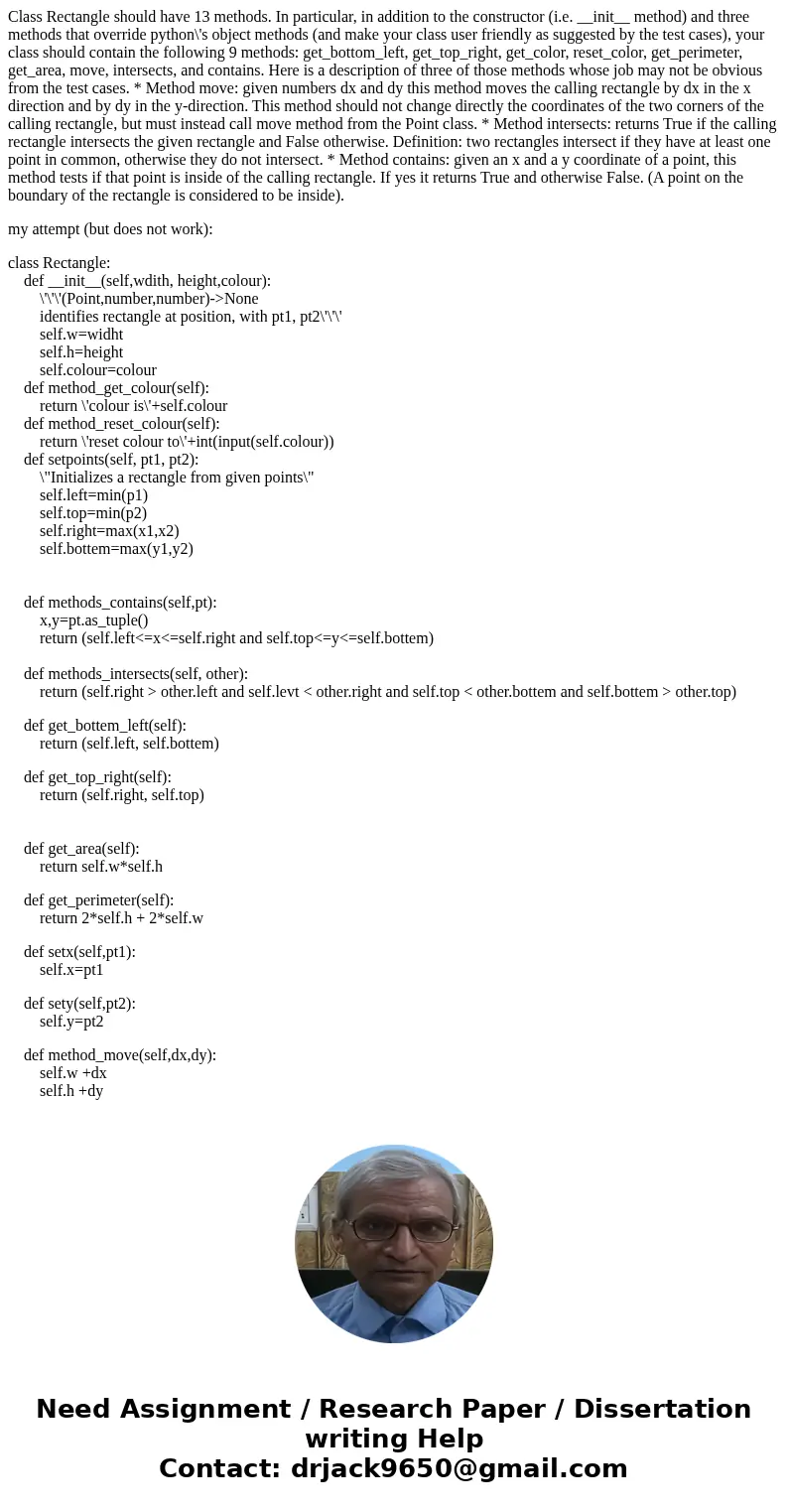
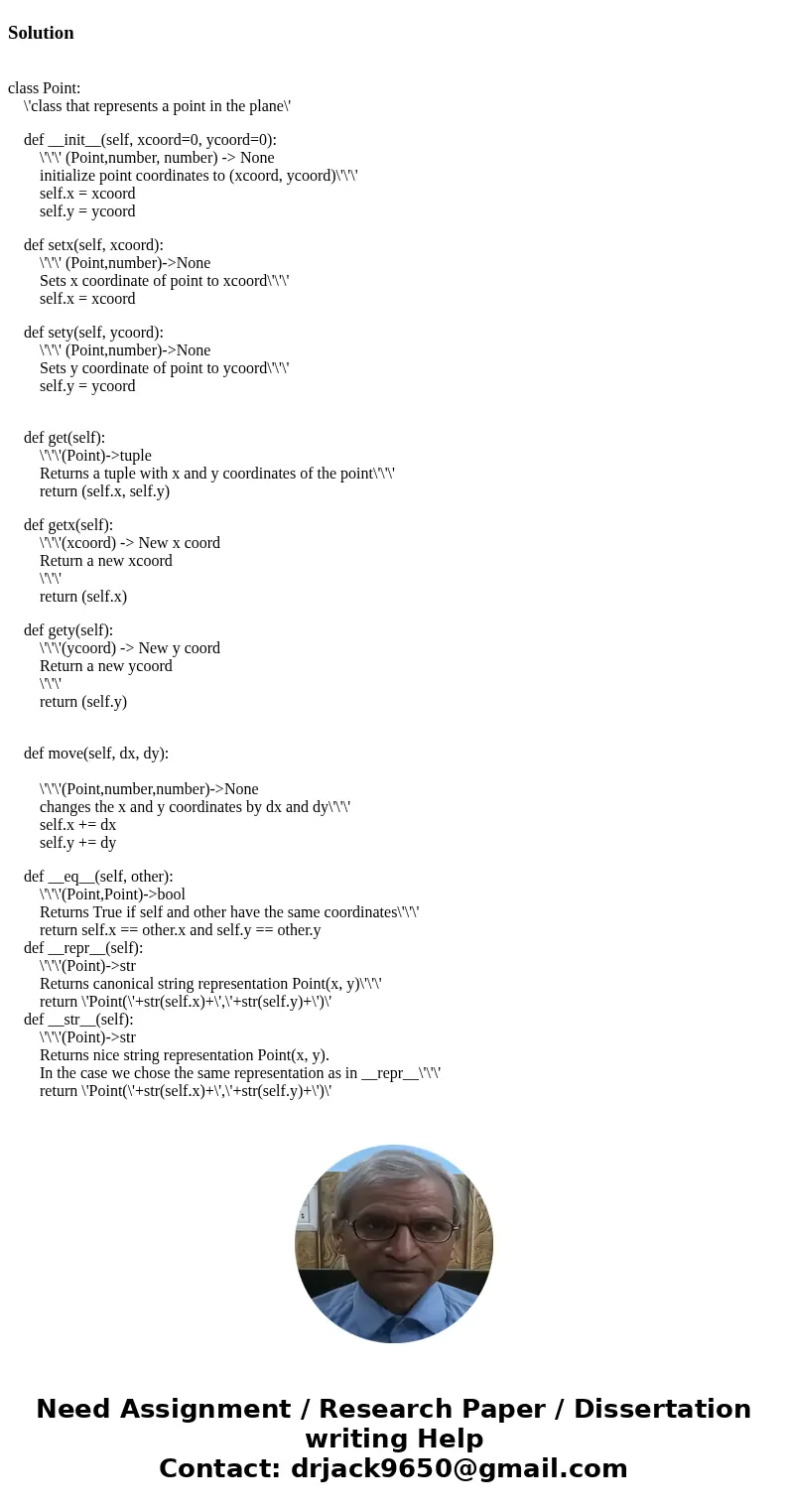
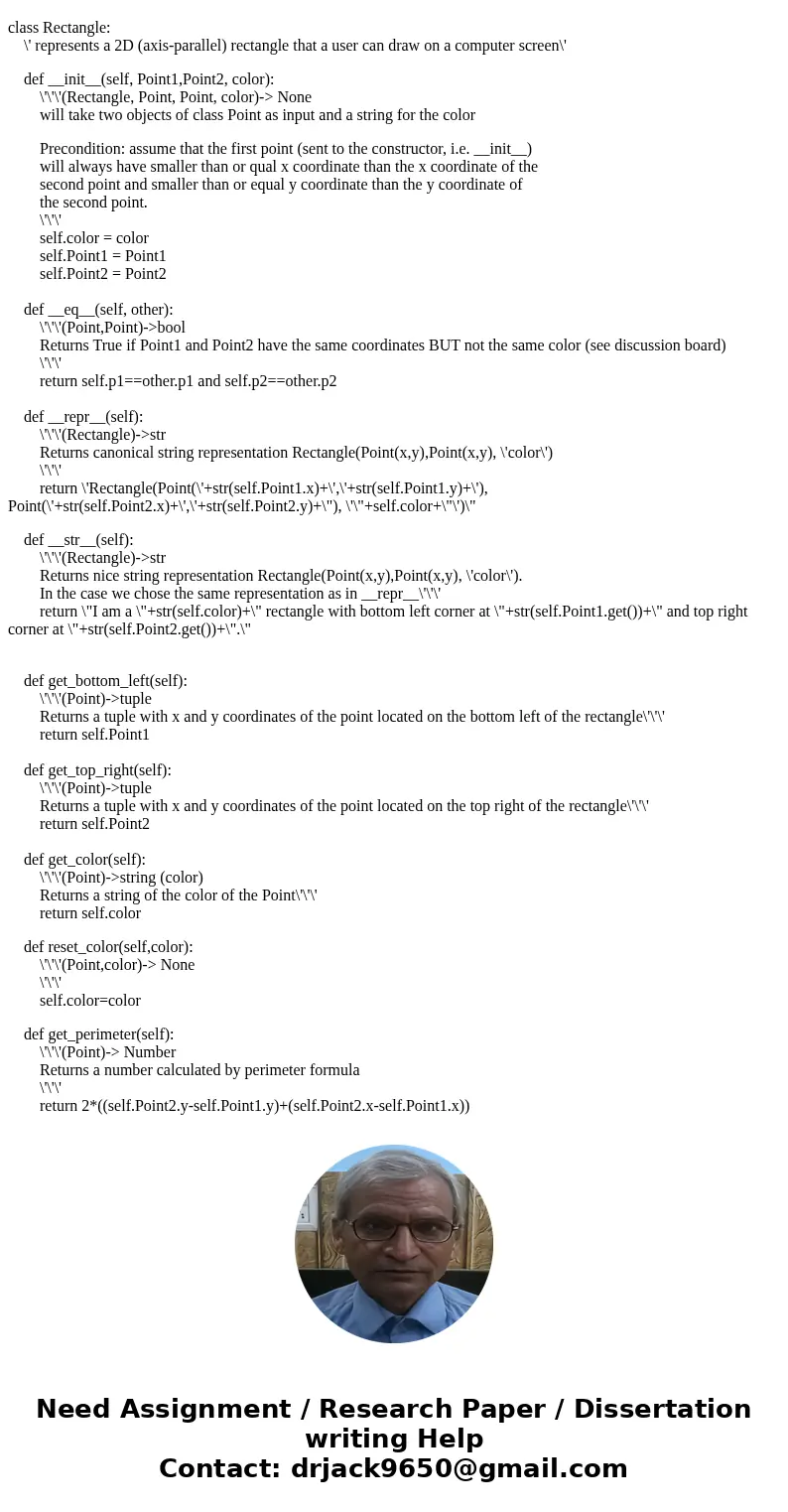
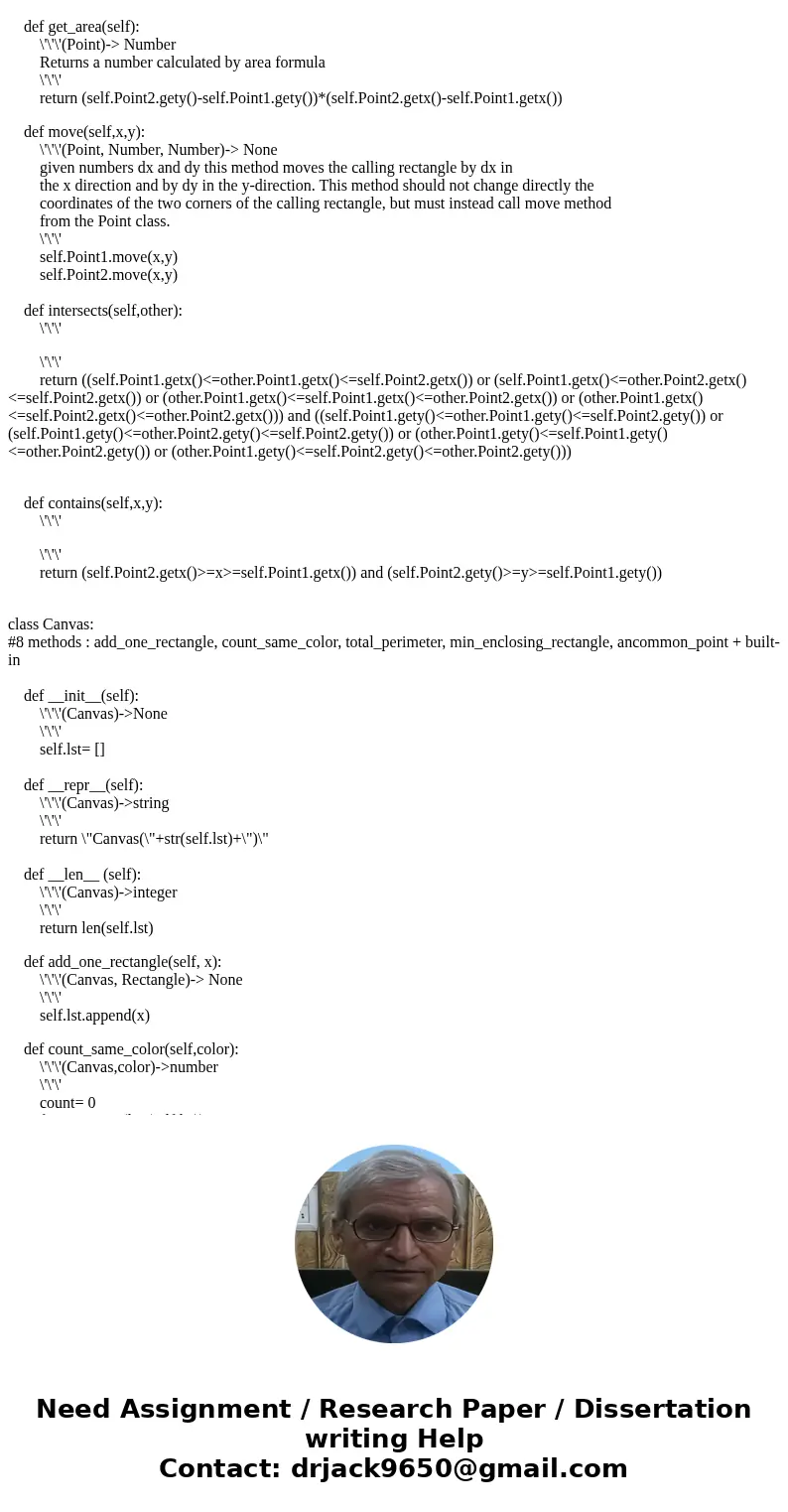
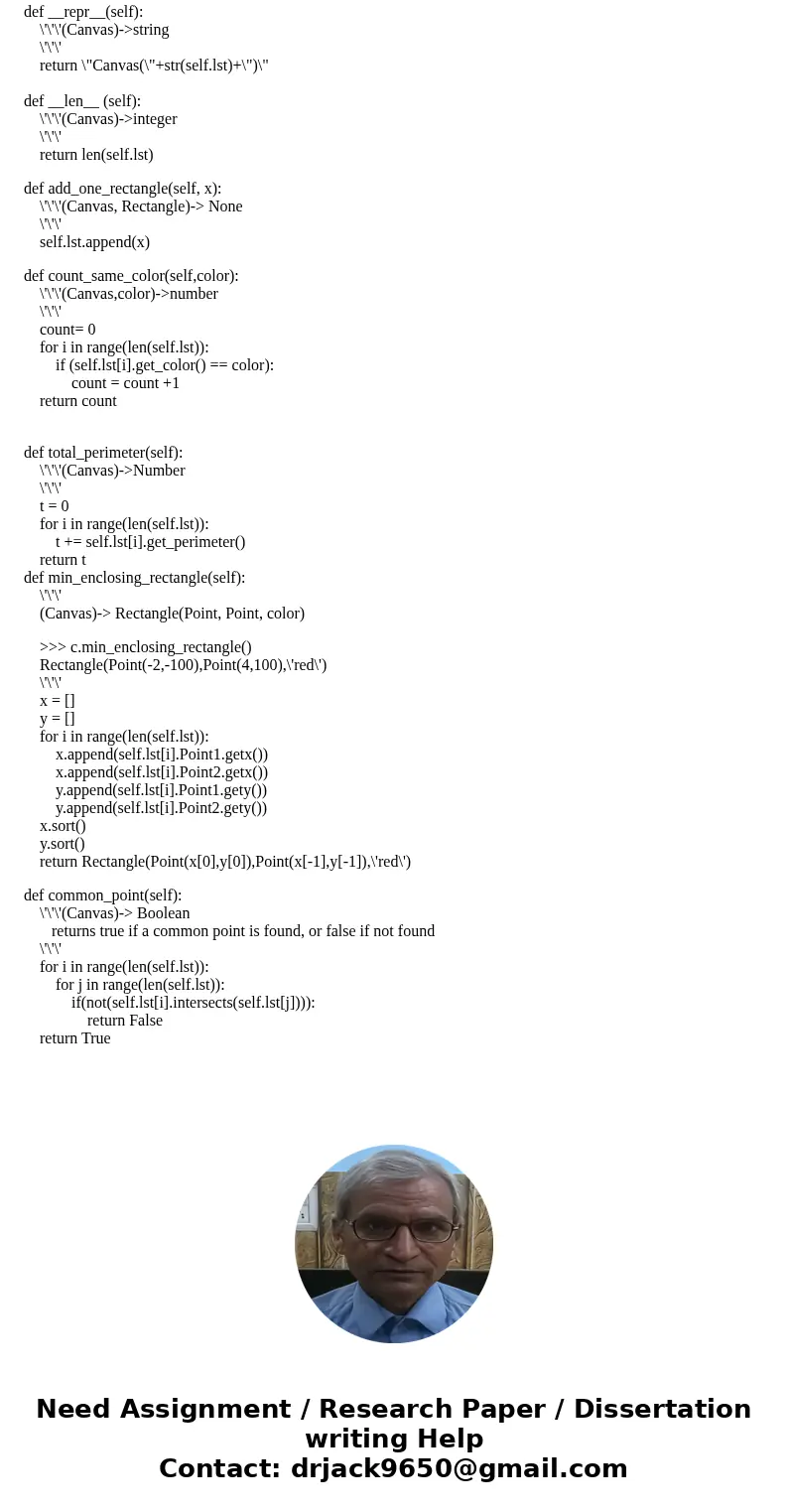
 Homework Sourse
Homework Sourse